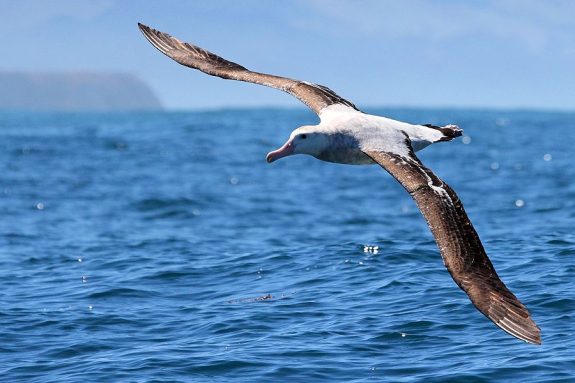Feathered ‘fingerprints’ reveal potential motivation for migratory patterns of endangered seabirds

University of South Australia Media Release
With the largest wingspan of any living bird, the Wandering Albatross is a giant of the sea. But like several other tube-nosed bird species, it is under threat of extinction.
Now, world first research from CSIRO and the University of South Australia shows that the feathers of seabirds such as the Wandering Albatross can provide clues about their long-distance foraging, which could help protect these species from further decline.
Comparing 15 element concentrations in the feathers of 253 tube-nosed seabirds of the Southern Hemisphere (representing 15 species), researchers found that the feathers of large seabirds (400g+) such as the Wandering Albatross (and other highly mobile seabirds) contained nutrients that did not solely match the availability of nutrients in the seawater at the collection site.
Conversely, smaller bird species that foraged more locally had feathers with trace element concentrations that were ten-to-hundred-fold higher than those of larger bird species, clearly representing the ocean basins in which they were feeding.
UniSA’s Associate Professor S. ‘Topa’ Petit says feather profiles can help decipher the movements and habitats of open ocean seabirds.
“From the lab work led by Dr Farzana Kastury, we found that small seabirds’ feathers contained substantial amounts of elements that matched their foraging environments, whereas large seabirds, irrespective of which ocean their feathers were collected from, all showed similar trace elements, suggesting they are feeding from a range of different ocean basins,” Assoc Prof Petit says.
“Small birds that spend a lot of time feeding on planktonic crustaceans in particular areas acquire specific elements from those areas. In contrast, larger birds do not have the same element signature because they forage across multiple ocean basins.
“Our work with feathers may explain why species like the Wandering Albatross that breed slowly and that are difficult to study because of their open ocean habits travel over such extraordinary distances.
“It points at the significance of micronutrient availability and associated ocean processes in the conservation of seabirds.”
Research leader, CSIRO’s Dr Lauren Roman, says understanding factors that affect the distribution of a threatened group of seabirds will help us better protect them in the future.
“It’s fascinating to think that highly mobile marine animals may be travelling long distances to meet their mineral needs, in addition to their energy needs,” Dr Roman says.
“But what this also tells us is that we must continue to protect biodiverse marine areas to ensure micronutrient availability for threatened bird species.
“One of the biggest threats to biodiverse marine areas is climate change, as it has the potential to affect nutrient cycles and distribution across the Southern Ocean.
“While more research needs to be done, this work expands our ecological knowledge about oceanic species and the significance of micronutrient availability for the survival of seabirds like the Wandering Albatross.”
Like what we do at The AIMN?
You’ll like it even more knowing that your donation will help us to keep up the good fight.
Chuck in a few bucks and see just how far it goes!
Your contribution to help with the running costs of this site will be gratefully accepted.
You can donate through PayPal or credit card via the button below, or donate via bank transfer: BSB: 062500; A/c no: 10495969










2 comments
Login here Register here-
wam -
Canguro
Return to home pageOne of the sadest things I have seen was a 20th century doco on long liners with albatrosses diving for the bait and getting hooked and drowning.
The sight of the drowned birds when the lines were retieved was terrible.
I expect they have solved that problem but this old cynic knows fishers value volume and cash.
So much speculation, so little understanding. Full marks for trying though, and in the spirit of scientific endeavour, proposing a hypothesis that may or may not be allied to the actuality of these bird’s behaviours. It’s always a difficult ask, for humans to engage in the challenge of understanding the minutiae of other species’ behaviours, given that to a large extent we don’t even understand our own. I admit that despite having been a birdo for the greater part of my life, and having always been able to take interest and pleasure in observing the behaviour of birds, I’ve never seen an albatross and expect I never will, nevertheless, just as with other creatures, they do what they do and scientists set out to discover why it is that they do what they do; and it seems that it’s in our nature to conduct such enquiries, and ultimately we’re the better off for those understandings.
Personally, I’m comfortable with the knowledge that albatrosses glide on the wind and forage the oceans and have been doing this for millennia. Whether it’s a function of the search for micronutrients or not, is not high in my estimation of the presence of these beautiful creatures; that’s for science to determine, and as to the birds themselves, given that they most certainly don’t ruminate or question as to why they glide, and just do what they do, long may they survive and I hope that GW doesn’t knock them off their perch… although it just might.